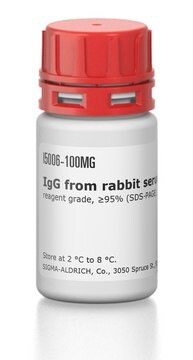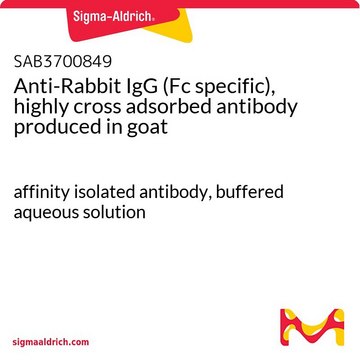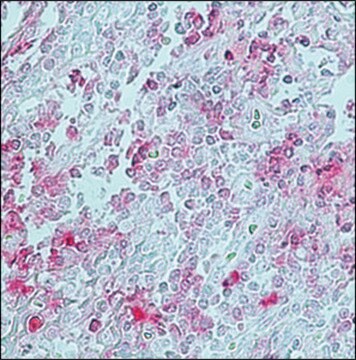SAB3700848
Anti-Rabbit IgG (Fc specific) antibody produced in goat
affinity isolated antibody, buffered aqueous solution
Zaloguj sięWyświetlanie cen organizacyjnych i kontraktowych
About This Item
Kod UNSPSC:
12352203
NACRES:
NA.46
Polecane produkty
pochodzenie biologiczne
goat
Poziom jakości
białko sprzężone
unconjugated
forma przeciwciała
affinity isolated antibody
rodzaj przeciwciała
secondary antibodies
klon
polyclonal
Formularz
buffered aqueous solution
reaktywność gatunkowa
rabbit
stężenie
1.99 mg/mL
metody
ELISA: suitable
immunohistochemistry: suitable
western blot: suitable
Warunki transportu
wet ice
temp. przechowywania
2-8°C
docelowa modyfikacja potranslacyjna
unmodified
Opis ogólny
Immunoglobulin G (IgG) is a member of the immunoglobulin family and is a widely expressed serum antibody. The monomeric 150kDa structure of IgG constitutes two identical heavy chains and two identical light chains with molecular weight of 50kDa and 25kDa, respectively. The primary structure of this antibody also contains disulfide bonds involved in linking the two heavy chains, linking the heavy and light chains and resides inside the chains. IgG is further subdivided into four classes namely, IgG1, IgG2, IgG3, and IgG4 with different heavy chains, named γ1, γ2, γ3, and γ4, respectively. Limited digestion using papain cleaves the antibody into three fragments, two of which are identical and contain the antigen-binding activity. The third fragment does not possess antigen-binding activity and is known as fragment crystallizable (Fc). It interacts with cells and effector molecules. The Fc fragment contains the CH2 and CH3 domains of the antibody molecule. Maternal IgG is the only antibody transported across the placenta to the fetus. It passively immunizes the infants.
Immunoglobulin G (IgG) is made up of a γ heavy chain in the constant (C) region. The monomeric 150kDa structure of IgG constitutes two identical heavy chains and two identical light chains with molecular weight of 50kDa and 25kDa, respectively. The primary structure of this antibody also contains disulfide bonds involved in linking the two heavy chains, linking the heavy and light chains and resides inside the chains. IgG is further subdivided into four classes namely, IgG1, IgG2, IgG3, and IgG4 with different heavy chains, named γ1, γ2, γ3, and γ4, respectively. Limited digestion using papain cleaves the antibody into three fragments, two of which are identical and contain the antigen-binding activity. The third fragment does not possess antigen-binding activity and is known as fragment crystallizable (Fc). It interacts with cells and effector molecules. The Fc fragment contains the CH2 and CH3 domains of the antibody molecule. Maternal IgG is the only antibody transported across the placenta to the fetus. It passively immunizes the infants.
Specyficzność
This product was prepared from monospecific antiserum by immunoaffinity chromatography using Rabbit IgG coupled to agarose. Assay by immunoelectrophoresis resulted in a single precipitin arc against Anti-Goat Serum, Rabbit IgG, Rabbit IgG F(c) and Rabbit Serum. No reaction was observed against Rabbit IgG F(ab′)2.
Immunogen
Rabbit IgG F(c) fragment
Zastosowanie
Anti-Rabbit IgG (Fc specific) antibody produced in goat has been used in immunohistochemistry.
Anti-Rabbit IgG (Fc specific) antibody produced in goat has been used in immunohistochemistry.
Właściwości fizyczne
Antibody format: IgG
Postać fizyczna
Supplied in 0.02 M Potassium Phosphate, 0.15 M Sodium Chloride, pH 7.2
Oświadczenie o zrzeczeniu się odpowiedzialności
Unless otherwise stated in our catalog or other company documentation accompanying the product(s), our products are intended for research use only and are not to be used for any other purpose, which includes but is not limited to, unauthorized commercial uses, in vitro diagnostic uses, ex vivo or in vivo therapeutic uses or any type of consumption or application to humans or animals.
Ta strona może zawierać tekst przetłumaczony maszynowo.
Nie możesz znaleźć właściwego produktu?
Wypróbuj nasz Narzędzie selektora produktów.
Kod klasy składowania
12 - Non Combustible Liquids
Klasa zagrożenia wodnego (WGK)
nwg
Temperatura zapłonu (°F)
Not applicable
Temperatura zapłonu (°C)
Not applicable
Wybierz jedną z najnowszych wersji:
Masz już ten produkt?
Dokumenty związane z niedawno zakupionymi produktami zostały zamieszczone w Bibliotece dokumentów.
Klienci oglądali również te produkty
Inhibition of Reactive Gliosis in the Retina of Rats with Streptozotocin-Induced Diabetes under the Action of Hydrated C60 Fullerene
Victor S
Neurophysiologia null
Inhibition of Reactive Gliosis in the Retina of Rats with Streptozotocin-Induced Diabetes under the Action of Hydrated C60 Fullerene
Victor S
Neurophysiologia null
Janeway CR
Immunobiology (2001)
S Guerrero et al.
Bioelectrochemistry (Amsterdam, Netherlands), 133, 107484-107484 (2020-02-23)
Electro-click methodology was employed to prepare an electrochemical immunosensor for the cytokine interleukin 1β (IL-1β). The strategy involved binding of ethynylated IgG to azide-MWCNTs modified electrodes by Cu(I) catalyzed-cycloaddition reaction where the catalyst was electrochemically synthesized. This electro-click protocol is
Janeway CR
Immunobiology (2001)
Nasz zespół naukowców ma doświadczenie we wszystkich obszarach badań, w tym w naukach przyrodniczych, materiałoznawstwie, syntezie chemicznej, chromatografii, analityce i wielu innych dziedzinach.
Skontaktuj się z zespołem ds. pomocy technicznej










